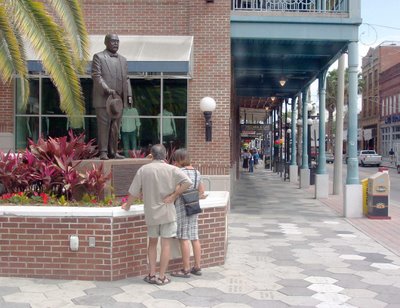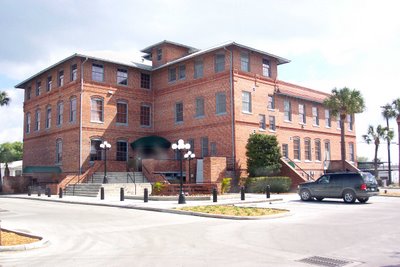
William M. Dowd photos
Visitors view the statue of Vicente Martinez Ybor.
TAMPA, FL -- As the sun beat down on the broad roof of the Ybor Cigar Factory, a man in a crisp, white guayabera shirt walked down the aisle between rows of tables stacked high with tobacco leaves, headed for an elevated platform with a single chair in its center.
To the contrasting rhythms of overhead fans lazily moving the air through the cavernous room and dozens of hands deftly rolling premium cigars, the man took the chair and began reading aloud to the latest shift of workers, part of the 4,000-worker force here at the world's largest cigar factory.  Newspapers, poetry, novels, all were fuel for the reader's efforts that informed, entertained, even distracted the cigar makers, people who in many cases had only their labors in common.
Newspapers, poetry, novels, all were fuel for the reader's efforts that informed, entertained, even distracted the cigar makers, people who in many cases had only their labors in common.
That, from the late 1890s to the early 1960s, was a commonplace sight in Ybor City, the polyglot community on the east side of Tampa that at one time employed 18,000 workers in literally dozens of large and small cigar factories and shops that made it the cigar capital of the world.
The factory reader was more than entertainment for the workers. His efforts formed the basis of an education in English for people who had flocked here from Spain, Cuba, Italy, Romania, Germany, even China to find work in the factories, and for whom English was, at best, a second language.
A vibrant, bustling multi-national community grew up around the factories, full of ethnic social organizations whose vestiges remain today, as well as nightclubs, restaurants, small shops, art galleries -- everything that today would draw free-spending tourists.
For Ybor (pronounced EE-bore), however, much of that community infrastructure is just now being recovered or rebuilt, having succumbed to a series of economic downturns, mechanical advances, changes in health consciousness, and that scourge of the 1960s known as "urban renewal."
Urban renewal, that federally-funded and, arguably, misguided program of modernizing cities by urging demolition of their old architecture, in the 1960s delivered a devastating blow to Ybor City's history. Seventy acres of what once had been a separate city were leveled.
Literally hundreds of residential structures were razed to make way for an interstate highway and little else despite ambitious plans for extensive development. Today, thanks to the unflagging efforts of various civic organizations that really began taking hold in the late 1990s, much of the Ybor City that had fallen into disrepair and neglect has been revived.
Art shops, casual dining places, nightlife offerings ranging from traditional Flamenco dancing to hip comedy, plus pocket parks and tourist sites all have helped revive the 500-acre remains.
The resurgence stumbled a bit in the early years of this century, but in the past two years has regained momentum. My most recent visit, just last week, shows a growing number of new bars, restaurants and boutique shops as well as an even greater number of festival-style events.
Ybor is an easy place to navigate, truly a walkers' delight, with several centrally located public parking lots, and plenty of benches for taking a break. Those with less energy can grab one of the RetroStar Pedicabs.
Once you get there, that is.
Most visitors begin in Tampa, then join the eastbound traffic backup at the 20th Street exit of Interstate 4, still the fastest way from Tampa proper. More than 60 bars, nightclubs and restaurants draw up to 30,000 people to Ybor on weekend nights.
Four years ago, the 2.3-mile TECO Line Streetcar System debuted, linking numerous tourist attractions and remote parking areas. The line serves the "visitors crescent" that covers the Tampa Convention Center, the Ice Palace, Garrison Seaport and Florida Aquarium close to downtown Tampa as well as the historic Ybor City district.
The line boasts some pristine renovated trolley cars, but it is more than merely decorative. Last year an estimated 400,000 riders took advantage of the inexpensive rates -- a $2 one-way cash fare, a $4 all-day pass, and various discount packages.
Ybor, named for cigar magnate Vicente Martinez Ybor who founded the community in 1896, is a pleasantly schizophrenic community. A self-guided daytime walking tour will take you from viewing the remaining former cigar factories that have been put to other uses to various statues of local luminaries to Centro Ybor, the commercial center of the community where shopping, dining and nightlife are packed cheek-to-jowl in a curious architectural arrangement -- a bi-level set of brick structures split by Seventh Avenue, Ybor's main thoroughfare.
Many cigar workers lived in casitas, small single-story homes. Three of them have been restored and are part of the Ybor City State Museum at 1818 Ninth Ave. The museum also offers walking tours of Ybor.
One of the renovated cigar factories is now Ybor Square, a mall filled with dining and retail establishments at 1901 North 13th Street. The 113-year-old building is listed in the National Register of Historic Places.
The Ybor City Brewing Co. -- its Ybor Gold is one of the favorite local beers -- is located in another renovated cigar building, a 104-year-old brick structure at 2205
North 20th Street.
Still another is the 99-year-old former Lozano cigar factory that has been converted to house the Central Florida Lions Eye & Tissue Bank, the world's largest eye bank,
at 1410 North 21st Street.
By day, shoppers, business people, and strolling retirees create comparatively little noise. By night, Ybor is Tampa's hottest hotspot, with a plethora of nightclubs, bars, comedy clubs such as The Improv or the Comedy Works, and casual restaurants drawing everything from college-age kids to Baby Boomers and beyond.
The $50 million Centro Ybor complex includes a 20-screen theater and a high-tech arcade, but even though such offerings usually cater primarily to the younger set, the management has made it more adult-friendly at night with its parental escort policy. After 8 p.m., no one under 18 is allowed in unless accompanied by a guardian 21 or older.
The range of offerings throughout Ybor pays tribute to the community's multicultural sensibilities, from the Irish kitsch of the James Joyce Pub to the drag shows at La
Femme Buvette or the Pleasuredome, or the Georgia/Carolina atmosphere of Moses White & Sons BBQ.
The Green Iguana (there also is one in nearby St. Petersburg) is one of the most popular spots for both social interaction and downright fine food, particularly what is colloquially known as "Floribbean" food, studded with the likes of grouper tacos, fajitas and Jimmy Buffet-esque cheeseburgers. Streetcar Charlie's, one of my favorites, has a large bar and a nice dining area with floor-to-ceiling windows that make it a great spot for people watching while enjoying a good lunch or dinner.
Then there is Gaspar's Grotto, a 10,000 square foot mecca for barbecue events and live entertainment on a large stage in the restaurant courtyard. Inside, a huge bar as well as a pool table-and-sports-TV area take up most opf the room.
The establishment is owned and run by Eric Schiller, a voluble transplanted Bostonian who spent decades at sea, captaining tankers before putting down on land a few years ago when, as he told me during lunch some time ago, "It dawned on me that it might be better to raise a family on dry land."
His love of beer is shown in his willingness to take visitors on a tour of his huge walk-in beer chiller located behind the courtyard of his East Seventh Avenue restaurant.
Those are examples of comparative newcomers. For a taste of old Ybor, I like the 1,200-seat Columbia, which celebrated its 100th anniversary in 2005. It's only a middling restaurant, but an excellent vestige of Flamenco culture, offering old-world Iberian ambiance in intricate tile work, vivid colors and haunting music.
My most enduring memory of a Flamenco show there was watching from a ringside table after dinner as one young lady energetically worked her way through a 20-minute ensemble performance, hammering away with the required powerful staccato steps despite a heavily bandaged ankle. That's show biz.
Lodging possibilities vary in Ybor. In addition to accommodations offered by the Hilton, Hyatt, Marriott and Holiday Inn chains -- the Hilton Garden Inn has an outdoor pool and an indoor workout room, there is my particular choice, the Don Vicente de Ybor Historic Inn, located on Republica de Cuba street.
It was constructed just before the turn of the 20th Century as an office complex by the founder of Ybor City and was used for numerous purposes, including a hospital, before falling into disrepair. Local developer Jack Shiver has restored it as a boutique hotel with gorgeous woods, mosaics and appointments.
Of course, if none of this appeals to you, you might be lured in by Ybor's version of Mardi Gras, a little something known as Guavaween, not to be confused with Tampa's Mardi Gras-style Gasparilla Festival held each February.
The October event draws 100,000 or more to Ybor each year, many in costume, to enjoy a lineup of festivals, concerts and a family fun fest.
Like Mardi Gras, the scene includes women in platform boots, skimpy attire and glitter, and some men similarly attired.
That, too is, show biz.


ON THE WEB
• Tampa Bay Convention & Visitors Bureau
• Ybor Online
• Dowd's Guides





